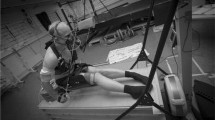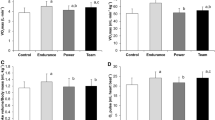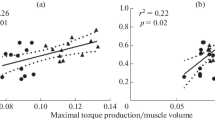Summary
Various aspects of neuromuscular, anaerobic, and aerobic performance capacity were investigated in four powerlifters, seven bodybuilders, and three wrestlers with a history of specific training for several years. The data (means ± SD) showed that the three subject groups possessed similar values for maximal isometric force per unit bodyweight (50.7±9.6, 49.3±4.1, and 49.3±10.9 N/kg, respectively).
However, significant (P<0.05) differences were observed in the times for isometric force production, so that e.g., times to produce a 30% force level were shorter for the wrestlers and bodybuilders (28.3±3.1 and 26.4±6.6 ms) than that (53.3±23.7 ms) for the powerlifters. Utilization of elastic energy by the wrestlers was significantly (P<0.05) better than that of the other two subject groups, as judged from differences between the counter-movement and squat jumps at 0, 40, and 100 kg's loads. No differences were observed between the groups in anaerobic power in a 1-min maximal test, but the values for \(\dot V_{O_2 } \) max were higher (P<0.05) among the wrestlers and bodybuilders (57.8±6.6 and 50.8±6.8 ml·kg−1·min−1) as compared to the powerlifters (41.9±7.2 ml ·kg−1·min−1). Within the limitations of the subject sample, no differences of a statistical significancy were observed between the groups in fibre distribution, fibre areas, or the area ratio of fast (FT) and slow (ST) twitch fibres in vastus lateralis. In all subjects the vertical jumping height was positively (P<0.01) correlated with the FT fibre distribution, and negatively with the time of isometric force production (P<0.05). Maximal force was correlated (P<0.001) with thigh girth. Muscle cross-sectional area did not correlate with mean fibre area. It was assumed that the selected aspects of neuromuscular, anaerobic, and aerobic performance capacity may be influenced by muscle structure, but also specifically and/or simultaneously by training lasting for several years.
Similar content being viewed by others
References
Asmussen E, Bonde-Petersen F (1974) Storage of elastic energy in skeletal muscle in man. Acta Physiol Scand 91: 358–392
Bergström J (1962) Muscle electrolytes in man. Scand J Clin Lab Invest [Suppl] 68
Blomstrand E, Ekblom B (1982) The needle biopsy technique for fiber type determination in human skeletal muscle — a methodological study. Acta Physiol Scand 116: 437–442
Bosco C, Komi PV (1979a) Mechanical characteristics and fiber composition of human leg extensor muscles. Eur J Appl Physiol 41: 275–284
Bosco C, Komi PV (1979b) Potentiation of the mechanical behaviour of the human skeletal muscle through pre-stretching. Acta Physiol Scand 106: 467–472
Bosco C, Komi PV (1982) Muscle elasticity in athletes. In: Komi PV (ed) Exercise and sport biology. Human Kinetics Publishers, Champaign, Ill, pp 109–117
Caiozzo V, Perinne J, Edgerton V (1981) Training-induced alternations of the in vivo force-velocity relationship of human muscle. J Appl Physiol: Respirat Environ Exerc Physiol 51: 750–754
Durnin J, Rahaman M (1967) The assessment of the amount of fat in the human body from the measurements of skinfold thickness. Br J Nutr 21: 681–689
Elder G, Bradbury K, Roberts R (1982) Variability of fiber distributions within human muscles. J Appl Physiol 53: 1473–1480
Gollnick P, Armstrong R, Saubert G, Piehl K, Saltin B (1972) Enzyme activity and fiber composition in skeletal muscle of untrained and trained men. J Appl Physiol 33: 312–319
HÄggmark T, Jansson E, Svane B (1978) Cross-sectional area of the thigh muscle in man measured by computed tomography. Scand J Clin Lab Invest 38: 355–360
HÄkkinen K, Komi PV (1981) Effect of different combined concentric and eccentric muscle work regimens on maximal strength development. J Human Mov Studies 7: 33–44
HÄkkinen K, Komi PV (1983) Alterations of mechanical characteristics of human skeletal muscle during strength training. Eur J Appl Physiol 50: 161–172
HÄkkinen K, Viitasalo JT, Komi PV (1980) Die Wirkung unterschiedlich kombinierter konzentrischer und exzentrischer Muskelarbeit auf Kraft-Zeit-Merkmale der Beinstreckmuskulatur. Leistungssport 10: 374–381
HÄkkinen K, Komi PV, Tesch P (1981) Effect of combined concentric and eccentric strength training and detraining on force-time, muscle fibre, and metabolic characteristics of leg extensor muscles. Scand J Sports Sci 3: 50–58
Ikai M (1970) Training of muscle strength and power in athletes. Presented at the FIMS Congress, Oxford
Ikai M, Fukunaga T (1968) Calculation of muscle strength per unit cross-sectional area of human muscle by means of ultrasonic measurements. Int Z Angew Physiol 26: 26–32
Katch V, Katch F, Moffatt R, Gittleson M (1980) Muscular development and lean body weight in bodybuilders and weightlifters. Med Sci Sports 12: 340–344
Komi PV (1973) A new electromechanical ergometer. 3. Int. Seminar für Ergometrie, Berlin
Komi PV, Buskirk E (1972) Effect of eccentric and concentric muscle conditioning on tension and electrical activity of human muscle. Ergonomics 15: 417–434
Komi PV, Bosco C (1978) Utilization of stored elastic energy in leg extensor muscles by men and women. Med Sci Sports 10: 261–265
Komi PV, Luhtanen P, Viljamaa K (1974) Measurement of instantaneous contact forces on the force-platform. Research Reports from the Department of Biology of Physical Activity, University of JyvÄskylÄ, Finland [No 5]
Komi PV, Rusko H, Vos J, Vihko V (1977) Anaerobic performance capacity in athletes. Acta Physiol Scand 100: 107–114
Komi PV, Karlsson J, Tesch P, Suominen H, Heikkinen E (1982) Effects of heavy resistance and explosive type strength training methods on mechanical, functional and metabolic aspects of performance. In: Komi PV (ed) Exercise and sport biology. Human Kinetics Publishers, Champaign, Ill, pp 90–102
Kroll W, Clarkson P, Kamen G, Lambert J (1980) Muscle fibre type composition and knee extension isometric strength fatigue patterns in power- and endurance-trained males. Res Quarterly Exercise Sport 51: 323–333
MacDougall J, Elder G, Sale D, Moroz J, Sutton J (1980) Effects of strength training and immobilisation on human muscle fibres. Eur J Appl Physiol 43: 25–34
MacDougall J, Sale D, Elder G, Sutton J (1982) Muscle ultrastructural characteristics of elite powerlifters and bodybuilders. Eur J Appl Physiol 48: 117–126
Padykula H, Herman E (1955) The specificity of the histochemical method of adenosine triphosphatase. J Histochem Cytochem 3: 170–195
Rusko H, Havu M, Karvinen E (1978) Aerobic performance in athletes. Eur J Appl Physiol 38: 151–159
Salmons S, Vrbova G (1969) The influence of activity on some contractile characteristics of mammalian fast and slow muscles. J Physiol 201: 535–549
Schantz P, Randall-Fox E, Norgren P, Typén A (1981) The relationship between the mean muscle fibre area and the muscle cross-sectional area of the thigh in subjects with large differences in thigh girth. Acta Physiol Scand 113: 537–539
Schantz P, Randall-Fox E, Hutchinson W, Typén A, åstrand P-O (1983) Muscle fibre type distribution, muscle cross-sectional area and maximal voluntary strength in humans. Acta Physiol Scand 117: 219–226
Spitler D, Diaz F, Horvath S, Wright J (1980) Body composition and maximal aerobic capacity of bodybuilders. J Sports Med 20: 181–188
Szögy A, Cherebetiu C (1974) Minutentest auf dem Fahrradergometer zur Bestimmung der anaeroben KapazitÄt. Eur J Appl Physiol 33: 171–176
Tesch P, Karlsson J (1978) Isometric strength performance and muscle fibre type distribution in man. Acta Physiol Scand 103: 47–51
Tesch P, Larsson L (1982) Muscle hypertrophy in bodybuilders. Eur J Appl Physiol 49: 301–306
Thorstensson A (1976) Muscle strength, fibre types and enzyme activities in man. Acta Physiol Scand [Suppl] 443
Viitasalo J, Komi PV (1978) Force-time characteristics and fiber composition in human leg extensor muscles. Eur J Appl Physiol 40: 7–15
Viitasalo J, MÄkinen P (1980) Comparison of five different methods for determination of muscle fibre areas. Presented at the Fifth Puijo Symposium 6–8 August 1980, Kuopio, Finland [Poster]
Viitasalo J, Saukkonen S, Komi PV (1980) Reproducibility of measurements of selected neuromuscular performance variables in man. Electromyogr Clin Neurophysiol 20: 487–501
Viitasalo J, HÄkkinen K, Komi PV (1981a) Isometric and dynamic force production and muscle fibre composition in man. J Human Mov Studies 7: 199–209
Viitasalo JT, Aura O, HÄkkinen K, Komi PV, Nikula J (1981b) Untersuchung von Trainingswirkungen auf die Krafterzeugung und Sprunghöhe. Leistungssport 11: 278–281
Widerman P, Hogan R (1982) Body weight loss in a wrestler preparing for competition: a case report. Med Sci Sports Exerc 14: 413–418
Author information
Authors and Affiliations
Rights and permissions
About this article
Cite this article
HÄkkinen, K., Alén, M. & Komi, P.V. Neuromuscular, anaerobic, and aerobic performance characteristics of elite power athletes. Europ. J. Appl. Physiol. 53, 97–105 (1984). https://doi.org/10.1007/BF00422570
Accepted:
Issue Date:
DOI: https://doi.org/10.1007/BF00422570




